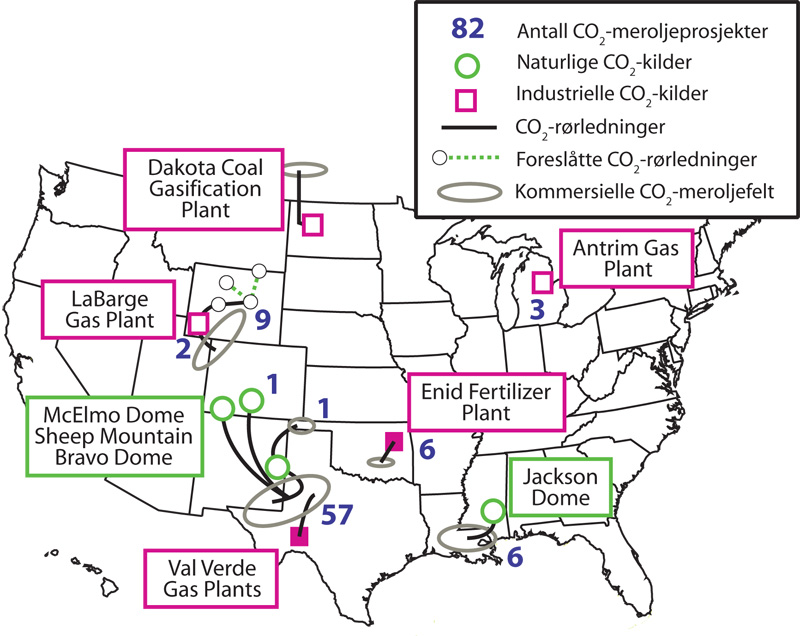> Transporting CO2 by pipeline
At industrial scales of emission pipelines are the the most economical way of transporting CO2 over distances up to 1000 km or more, depending on specific conditions. Offshore pipelines are generally more expensive to build and maintain than onshore pipelines, but are still more economical than ship transport up to hundreds of kilometers in most cases.
CO2 has been used extensively for enhanced oil recovery (EOR) in the USA for decades, and several long distance pipelines for CO2 are in operation. These pipelines transport 50 MtCO2 pr year, over a total distance of more than 2500 km.

Much useful experience in long distance pipeline transport of liquefied gas through challenging environments has been gathered from natural gas transport.
Transporting CO2 by pipeline
CO2 is generally not transported in its gaseous phase. CO2 changes to a liquid at 5.85 MPa at 20°C and becomes supercritical at 7.39 MPa at temperatures above the critical temperature of 31.1°C. The supercritical phase is preferable for transport but maintaining critical temperature and pressure at all stages of long distance transport in unlikely. High volume pipeline system will generally be designed for multiphase transport.
It may me necessary to remove impurities from the CO2 stream before transport. The exact requirements will vary depending on how the CO2 is used, whether it is transported through populated areas and the quality of the pipes. Low CO2 stream purity will also affect the physical properties of the gas stream, causing unwanted changes in flow rate and vapour point.
Oxygen and free water is usually removed from the stream to avoid corrosion. Dry CO2 does not cause corrosion in the carbon-manganese steel generally used in pipelines under ordinary circumstances. If the CO2 cannot be dried it can still be transported through corrosion-resistant (stainless) steel pipes, but this will significantly increase the cost of the pipeline.
When CO2 is transported through populated areas, only very low levels of toxic contaminants such as H2S would be acceptable, in case of leakage.
Existing experience

Existing CO2 infrastructure in the USA. (Source: Advanced Resources International)
CO2 has been transported by pipeline in the US since 1972, and today a total of more than 2500 km of CO2 pipeline is in operation, transporting 50 MtCO2 pr year. This projects have provided experiences in handling a wide range of conditions, including harsh winter climate (the Wyburn Pipeline, going from North Dakota to Saskatchewan, Canada) and mountainous terrain (the Cortez Pipeline crosses the Rocky Mountains from Colorado to New Mexico).
Less experience exists in long distance underwater CO2 transport. However, CO2 transport is largely analogous to transport of hydrocarbon gas such as LNG which is transported by underwater pipeline and at great distances many places in the world. Experiences from LNG pipelines are generally applicable to CO2 transport.
Safety
Land pipelines are built to defines standards and are subject to regulatory approval to assure a high level of safety, particularly in populated areas. Pipelines in operation are monitored internally by pigs (piston-like inspection devices that are driven through the pipeline by gas pressure) and externally by corrosion monitoring and leak detection systems. In the event of a leak, transport of gas is shut down automatically.
CO2 leaking from a pipeline is potentially a physiological hazard to humans and animals. As CO2 has a higher density than air, it may accumulate locally to dangerous levels under calm conditions. Particular care must therefore be taken when CO2 pipelines go through populated areas. This is similar to the challenges involved in pipeline transport of hydro-carbon gases.
When CO2 is transported through populated areas, specified maximums of toxic impurities would be set higher. If the CO2 contains significant levels of hydrogen sulphide, this could significantly increase the impact of a leak or rupture.
Source: Zero Emission Resource Organisation
<< Previous page
---
Next page >>
TOP
|





